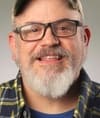Remembering West Hempstead's Island Garden, where the Nets, Bob Dylan and pro wrestlers all played
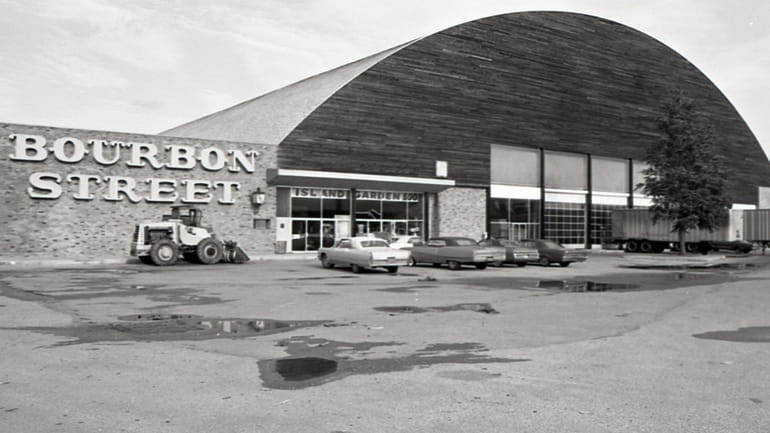
A 1973 photo of the Island Garden, a 5,200-seat arena built in 1957 in West Hempstead and torn down 50 years ago. The Bourbon Street fast-food restaurant was part of the arena. Credit: Newsday / Cliff De Bear
Most people are aware of the world’s most famous arena in Manhattan — Madison Square Garden and some may even have heard about Beantown’s Boston Garden, but did you know Long Island once had its own Garden?
Back in 1957, the Island Garden was erected in West Hempstead on the corner of Hempstead Turnpike and Cherry Valley Avenue. This venue preceded Nassau Coliseum, which opened in 1972 and the Long Island Arena in Commack, which began in 1959.
Nestled in the middle of suburban Nassau County, the 5,200-seat arena, owned by Arnold “Whitey” Carlson of West Hempstead, provided entertainment for Long Islanders until it was torn down 50 years ago.
“At the time, I viewed the Island Garden like our neighborhood movie theater,” says Susan Ryza, 70, who grew up in West Hempstead. “Now, looking back, I appreciate all the amazing acts we got to see there. It’s shocking actually.”
Louis Licitra, 70, of West Hempstead adds, “The Island Garden had a real presence to us. Concerts were easy to go to. In fact, it was walking distance from my house. I got to see some bands that turned out to be big.”
The Island Garden served many purposes over its 16 years of existence. Here’s a taste of what LI saw:
THE NETS' HOME COURT
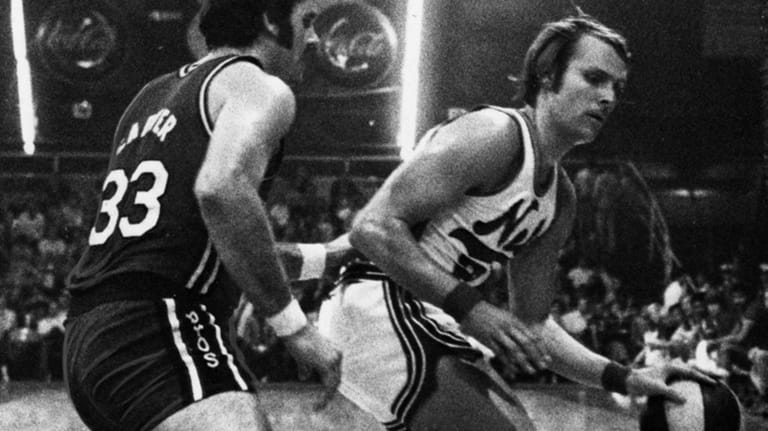
The New York Nets' Rick Barry, left, is guarded by the Memphis Pros' Wendell Ladner on Nov. 5, 1971, at the Island Garden. Credit: Newsday / George Argeroplos
The Island Garden got a major boost when the New York Nets of the American Basketball Association (ABA) vacated the Long Island Arena in 1969.
“The Long Island Arena in Commack wasn’t conducive for basketball because it was freezing cold due to the ice underneath the surface,” says Paul Brandel of Malverne. “The players used to sit on the sidelines with their winter coats on during the game. Plus, the condensation from the ice caused them to slip all over the place.”
Sports commentator Al Trautwig, 67, of Sag Harbor adds, “These guys were desperate for a chance. Being in the ABA at that point was second class stuff.”
One of the highlights of the Nets’ tenure at the Island Garden was the first interleague game with the NBA (National Basketball Association) when they took on the Boston Celtics on Oct. 3, 1971. (The rival leagues would officially merge in 1976.)
“The Nets beat them by one basket [116-115] with a last-second shot by Bill Melchionni. The place went wild! You would have thought they won the Olympic gold medal,” says Brandel. “I remember [Celtics star] Dave Cowens coming off the court just shaking his head in disbelief.”
Not only were tickets easy to obtain and affordable ($1-$5), but the players were even accessible to the fans.
Bill Melchionni of the New York Nets drives for a basket in an Island Garden game against the Pittsburgh Condors. Credit: Newsday
“Once I got an autograph from Rick Barry at the Island Garden when he was taken out of the game after scoring 48 points,” says John Kingston, 66, of Carle Place. “I came up to him right on the bench and he gave me his autograph. That would never happen at Madison Square Garden.”
Fans distinctly remember special evenings like Ball Night when the ABA's iconic red, white and blue basketballs were given out.
“They were a huge draw because you could tell whether or not you were shooting properly by the rotation of the ball,” says Trautwig, who worked as a Nets ball boy as a teenager.
The team even had a Turkey Night where they gave away 500 frozen turkeys in November 1968.
“They would call out ticket numbers,” says Kevin VanMeter, 70, who grew up in Franklin Square. “Winners went home with a 14-pound turkey.”
CONCERTS: DC5, DYLAN, CREAM AND MORE
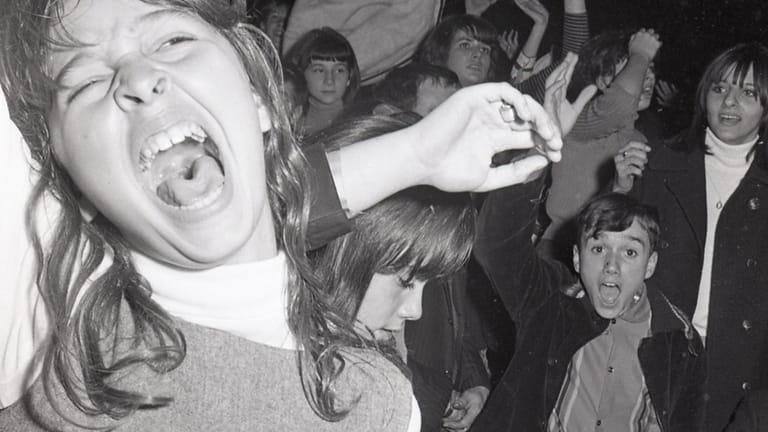
Fans scream and cheer for the English musical group Dave Clark Five, which performed at the Island Garden on Nov. 17, 1965. Credit: Newsday / Dick Morseman
Several classic rock music acts took the stage at the Island Garden over the years with tickets ranging from $3-$6. On Nov. 17, 1965, the Dave Clark Five was met with a pack of wild fans when the British Invasion band hit the stage.
“There were tons of screaming girls and it was very hard to hear,” says Larry Durso, 68, of Garden City South. “You really couldn’t make out the music. It was unbelievable.”
When Bob Dylan went electric his tour stopped at the Island Garden on Feb. 26, 1966.
“He started with an acoustic set where he played songs like ‘Don’t Think Twice, It’s All Right’ and ‘Blowin’ in the Wind,’ which was a bit low key,” says Charlie Savage, 73, who grew up in Garden City Park. “His second set was electric and he used the Hawks as his backing band, who eventually became known as The Band.”

Bob Dylan performs, while playing a Fender Stratocaster electric guitar, at the Island Garden on Feb. 26, 1966. Credit: Michael Ochs Archives / Alice Ochs via Getty Images
After the Rascals opened for the Byrds on March 25, 1966, they led their own show at the venue on May 13, 1967.
“We were greatly embraced by Long Island,” says lead singer/keyboardist Felix Cavaliere, 80. “The Island Garden was a unique place. Typically, you don’t see an arena in the middle of a nice suburban neighborhood.”
The band members had strong Long Island ties. They got their start playing at The Barge in Southampton during the summer of 1965 when they got signed to Atlantic Records.
“The Island Garden was a homecoming show and quite a treat,” says guitarist Gene Cornish, 78, of Woodbury. “Playing an arena was brand new territory for us. We only played clubs up until then.”
The power trio of guitarist Eric Clapton, drummer Ginger Baker and bassist/vocalist Jack Bruce known as Cream performed at the arena on June 14, 1968. However, the gig didn’t go off without a hitch.
“The band started very late. When they did play, the vocals were going in and out on the first song. It seems the PA system went down so the band simply jammed,” says Don Celenza, 69, of West Hempstead, who went to the concert. “Regardless of the lack of vocals, I thought it was great because the night became focused on Clapton’s guitar playing.”
On March 7, 1969, the late guitar legend Jeff Beck brought the Jeff Beck Group to the Island Garden on his “Truth” tour with Rod Stewart on vocals and Nicky Hopkins on piano. Savoy Brown and Mountain opened the show.
“I’m a guitarist myself, and Beck was clearly an inspiration for me,” says Donald E. Jones, 70, of Franklin Square, who attended the show. “In fact, I bought my first wah-wah pedal because of him.”
Sly & The Family Stone had the Island Garden grooving to the sounds of “Stand!” and “Everyday People” on Nov. 8, 1969.
“It was a wild event,” says Licitra, who was in the audience. “There was a lot of movement in the seats and passing around non-cigarettes.”
Other concerts included a three-part jazz fest featuring Louis Armstrong, Gene Krupa, Dizzy Gillespie and Duke Ellington in 1958, Johnny Cash in 1965 as well as Blood, Sweat & Tears and Procol Harum in 1969.
THE CIRCUS EVERY YEAR

The circus was an annual attraction at the Island Garden.
Every spring the circus would come to the Island Garden. However, this wasn’t the glossy Ringling Bros. and Barnum & Bailey Circus, but more earthy shows like Wirth’s Circus or the L.N. Fleckles & Co. Circus, which did two shows a day (three on Saturday). For $1-$4 a ticket, audiences would see acts like a tightrope walker, trapeze artists, a bearded lady, sword swallowers, fire eaters and Siberian tigers with their trainers.
“If you got there early you could walk behind the scenes to check out the animals and meet the clowns,” says Licitra. “It was pretty spectacular for a kid.”
Patrick Flannery, 57, of Farmingdale will never forget the time he got to ride atop an elephant with his father and sister when he was a child.
“It was an interesting experience,” recalls Flannery. “They had a box on top of the elephant and about six people would sit in it. You had to climb an airline-like staircase to get up there. It was thrilling.”
The big finale was quite a shocker.
“In the end, a guy in a white sequined uniform got shot out of a cannon from one end of the arena to the other into a net,” says Bruce Glover, 72, of Greenlawn. “Seeing him fly through the air with a puff of smoke behind him was a pretty cool sight.”
BRUNO, BOBO AND BUDDY

Bruno Sammartino, bottom, in a stranglehold from Professor Tanaka, was a popular attraction at the Island Garden. Credit: Bettmann Archive/Getty Images
Professional wrestling was on the rise in the late '60s-early '70s and the Island Garden became a hot spot for colorful matches with stars like Haystacks Calhoun, Arnold "Golden Boy" Skaaland, Bobo Brazil, Buddy Rogers and tag team the Fabulous Kangaroos.
“Bruno Sammartino was everybody’s favorite because he always got the crowd going,” says Ed Frederick, 66, of Malverne. “He really brought the action!”
People used to get so passionate they would throw their Sno-Kones at the bad guys.
“Everybody thought wrestling was real back then,” says Gerard Passaro, 67, of Long Beach. “People would actually cry when their favorite wrestler was getting beat up.”

Bobo Brazil was an Island Garden fan favorite. Credit: Bettmann Archive/Getty Images
Additional sporting events that used to fill the Island Garden include roller derby, an indoor rodeo, car racing and a boat show.
POLITICAL RALLIES

A poster for Martin Luther King's 1965 appearance at the Island Garden. Credit: West Hempstead Historical Society
Iconic political figures including Robert Kennedy and Rev. Dr. Martin Luther King, Jr. both appeared at rallies at the Island Garden in the '60s.
King spoke among fellow civil rights leaders Bayard Rustin, John Lewis and Lincoln Lynch in 1965. After visiting six communities in Nassau County, King addressed a full house, delivering a 40-minute speech that focused on criticizing the government for not having made the abolition of the poll tax an integral part of the 1965 Voting Rights Act.
“I think it is tragic that the Senate of this nation did not have the will to do away immediately with the poll tax in state elections,” said Dr. King, Newsday reported. “We heard our President [Lyndon B. Johnson] say that every obstacle to the right to vote must be removed. I submit to you that the poll tax is an obstacle to the right to vote.”
In 1964, Kennedy, then a Democratic candidate for U.S. Senate, spoke before an assembly of International Union of Electrical Radio and Machine Workers, Local 450 promising to help rebuild the area’s declining economy.
“I’m going to make an effort for Nassau County,” said Kennedy, according to Newsday. “I’m going to make an effort for Suffolk County. I’m going to make an effort for the IUE.”
Four years later, Kennedy, now a senator, was running for president and stumped again at West Hempstead arena for 45 minutes.
“Mr. Kennedy was talking about improving the roads and the streetlights. He made a pledge to help out Long Island and I bought into it,” says VanMeter. “Back then there was no internet, therefore to see a politician in person was exciting, and he was very charming.”
SCHOOL EVENTS
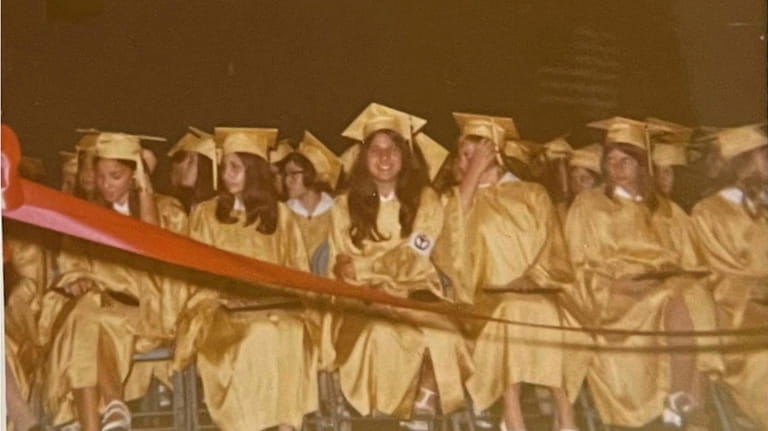
Susan Ryza, now 70, wears an armband at her 1970 graduation ceremony for West Hempstead High School held at the Island Garden. Credit: Susan Ryza
Some local school events took place at the Island Garden ranging from a high school basketball game to a graduation ceremony.
Christopher Lockwood, 68, who grew up in Oyster Bay, attended a St. Dominic’s High School basketball game in February 1970 where former Knicks coach and current Iona University basketball coach Rick Pitino of Bayville played point guard.
“If we had the 3-point shot rule back then Rick would have set records because of the way he could shoot,” says Lockwood.
When West Hempstead High School graduated 365 students in June 1970,, a political statement was quietly being made on the stage.
“We had strips of sheet fabric with a black peace sign drawn on them tied around our upper arms in protest of the Vietnam War,” says Ryza.
Licitra adds, “There was talk that we were going to be kicked out, but they didn’t have any kind of hold on us. My parents raised an eyebrow, but what were they going to do? I was 18.”
NOT JUST HOT DOGS
The concessions at the Island Garden were your typical hot dog, popcorn and soda menu. However, there were a few items that stood out from the general fare, such as bags of white chocolate, Sno-Kones and three-flavor walkaway sundaes on a cone.
“The cones were in the shape of a Cape Cod-style house,” recalls Joe Marinello, 66, of West Hempstead, who started working at the Island Garden at age 10 selling programs and concessions. “They were dipped in chocolate and came with a cherry on top.”
Before and after events, folks used to go to Bourbon Street, a fast-food restaurant in front of the Island Garden, which was also owned by Carlson. The place was decorated with memorabilia from the 1964-65 New York World’s Fair, including games like Skee-Ball, pinball and a basketball toss.
“It had a long counter and was similar to something you’d see in Coney Island, except indoors,” says Brandel. “They would have separate sections for hot dogs, hamburgers, soda, knishes, pizza, shakes and French fries. The seating would be picnic tables. All of the food was served cafeteria style.”
CLOSING DOWN

Cherry Valley Center, with its World's Fair Arch, is now on the site of the Island Garden. Credit: Rick Kopstein
The Island Garden closed in 1973 after the Nets moved its operations to Uniondale making Nassau Coliseum its new home.
“It just made sense for the Nets to move to Nassau Coliseum. This was a totally different world,” says Trautwig. “They were knocking on the door of the big leagues.”
Former Newsday photographer David Pokress, 70, of Farmingdale adds, “When they moved to Nassau Coliseum it was like going from the outhouse to the penthouse.”
The Nets went on to win two ABA championships in 1974 and 1976 after recruiting Julius Erving, aka “Dr. J,” who grew up in Roosevelt, and eventually the team became part of the NBA.
“Once Nassau Coliseum opened, that was it. There was nothing to put in the Island Garden anymore,” says Brandel. “The Nets moved and they couldn’t handle hockey. Concert acts would choose to play the Coliseum over the Island Garden. Just like now how all the acts are now going to UBS Arena over Nassau Coliseum. The cycle just continues.”
Today, the Island Garden site is the location of the Cherry Valley Center, a shopping center that includes a variety of businesses.A 60-foot arch from the World’s Fair still stands on the site today. It used to hold up a sign stating, “Peace Through Understanding.” Now it contains the mini billboards of the stores in the shopping center.
However, the arena's name lives on at the adjacent Island Garden Basketball, home of the Lightning, an AAU (Amateur Athletic Union) team and a local training arena utilized for youth basketball, owned by JMF Sports and operated by Jim Fox, which supports the motto “Ball for All.”
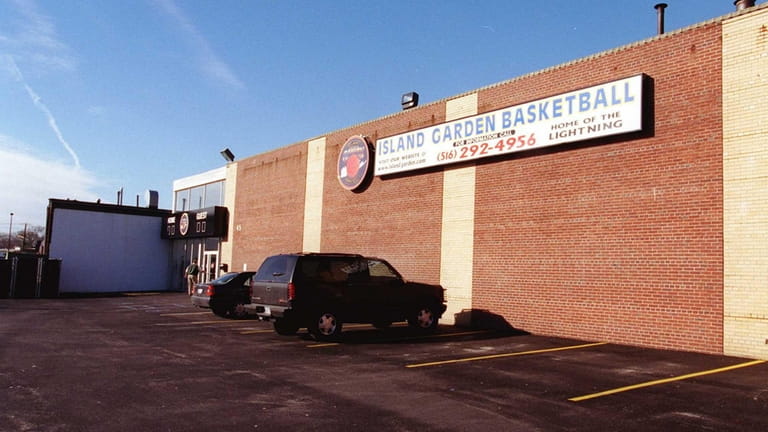
The Island Garden name lives on in this youth basketball facility adjacent to the old arena site. Credit: Newsday / K. Wiles Stabile
BALL BOY MADE GOOD
The Island Garden had a massive impact on a young man who grew up in Garden City South named Al Trautwig. He became fascinated with the Nets and went to every game for $1.
“It was something to do that was in my backyard,” says Trautwig, 67, who now lives in Sag Harbor. “I could walk there in 15 minutes.”
Eventually, Trautwig made friends with the Nets general manager and scored himself a job as a ball boy at age 14. His duties included cleaning up the locker room, rebounding for the players during practice, doing laundry, getting coffee and distributing tickets for the players to name a few.
“It was awesome,” says Trautwig. “I was at every timeout and shoot around in the afternoon. I spent hours there every day and I learned about every aspect of the game.”
When the Nets moved to Nassau Coliseum, Trautwig went with the team and even got promoted to head ball boy overseeing a group of ball boys.
“I had keys to the building. I’d take the bus there every day after school,” says Trautwig, who was there for the team’s 1974 ABA (American Basketball Association) championship. “I was vacuuming, cleaning and organizing. It was a full-time job. I spent well over 40 hours there per week.”
Trautwig went on to a prominent career as a professional sports announcer. He started calling NY Apollo soccer games on WBAU (90.3 FM) for Adelphi University. But he moved onto greater heights announcing for the USA Network, ABC, the MSG Network as well as doing commentary for eight Olympic Games.
“It all started from my time at the Island Garden,” says Trautwig. “It was a life changer.” — DAVID J. CRIBLEZ
